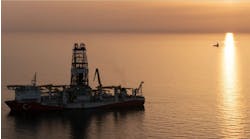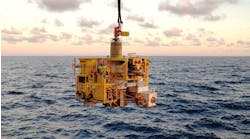Time - and oil - are running out for Pemex. The supergiant Cantarell field, which boasts the highest offshore crude oil production in the world, is seeing what could be a steep decline, hitting Mexico’s crude oil production and exports in the short-term. Output from Cantarell - which provides over half of Mexico’s total production - declined by 199,000 b/d, or 10.3%, in the first half of 2006, ending the semester with an output level of 1,739,000 b/d.
AsSpecial Correspondent David Shields points out in his report this month, Pemex appears to have few options to offset falling output in the near-term. The two best options may be the Ku-Zaap-Maloob complex and the Light Crude Oil Project, both of which, like Cantarell, are in the Bay of Campeche in southeastern Mexico. It seems unlikely, however, that either project could provide enough crude to compensate for lost output from Cantarell in the medium-term.
As a result, Pemex executives have been promoting Mexican deepwater as the major long-term offshore alternative to the declining shallow-water plays in Campeche Bay. Find out what this means for Mexico offshore E&P in Shields’ report beginning onpage 28
Meanwhile, offshore Brazil, because of its geological similarity to the adjacent and prolific Campos basin, the Santos basin has become an increasingly important hydrocarbon province. Most exploration in the Santos basin has been in shallow water, where fewer than 100 wells have been drilled with some oil and gas discovered (~ 6.3 MMbbl of oil in Tubarão and related fields, and ~0.17 tcf of gas in the Merluza field). This compares to over 1,130 wells drilled in the shallow and deepwater portions of the Campos basin.
The deepwater portion of the Santos basin, however, may prove to be the most important area for new reserves. In their special report on the newly emerging region,Joshua H. Rosenfeld of Yax Balam Inc. and John F. Hood of Veritas DGC explain why this promising new E&P region is emerging. Their piece begins on page 118
New mooring technology for GoM
Decades-old technology, supported by reliable modeling algorithms, may provide a more cost-effective solution in the future for mooring deepwater facilities in the Gulf of Mexico. During the last 10 years, Petrobras has used more than 200 torpedo piles, large cylindrical projectiles, as an economical method for anchoring deepwater facilities offshore Brazil. In this month’s deepwater technology section,Jean M.E. Audibert of Fugro-McClelland Marine Geosciences and Maurice N. Morvant, Jeong-Yun Won, and Robert B. Gilbert of the Department of Civil Engineering, University of Texas, explain why the technology may be adopted for use in the Gulf of Mexico. See their special report beginning on page 100.
Finally, don’t mis this year’s annualEnvironmental Drilling & Completion Fluids Directory, a listing of industry fluid manufacturers and their products.... Along with the directory, we bring you a discussion of the environmental and economic impacts of using an inverted-emulsion drilling fluid mitigated by managing mud constituents and treatment to reduce retention on cuttings. An integrated fluids engineering (IFE) concept was employed to realize these and additional benefits.... In the same technology section, read how ConocoPhillips has its sights on using directional casing drilling offshore. The idea came after applying casing drilling in over 120 wells in the Lobo trend of South Texas to reduce lost circulation and stuck pipe, and ultimately improve drilling efficiency.
Eldon Ball • Houston


